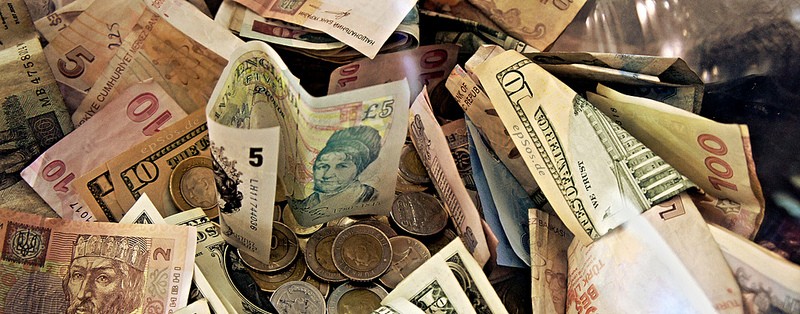U.S. interest rates have been rising, and most likely will continue to do so. The target level of the Federal Funds rate, currently at 1.75%, is expected to be raised at the June meeting of the Federal Open Market Committee. The yield on 10-year U.S. Treasury bonds rose above 3%, then fell as fears of Italy breaking out the Eurozone flared. That decline is likely to be reversed while the new government enjoys a (very brief) honeymoon period. What are the effects on foreign economies of the higher rates in the U.S.?
One channel of transmission will be through higher interest rates abroad. Several papers from economists at the Bank for International Settlements have documented this phenomenon. For example, Előd Takáts and Abraham Vela of the Bank for International Settlements in a 2014 BIS Paper investigated the effect of a rise in the Federal Funds rate on foreign policy rates in 20 emerging market countries, and found evidence of a significant impact on the foreign rates. They did a similar analysis for 5-year rates and found comparable results. Boris Hofmann and Takáts also undertook an analysis of interest rate linkages with U.S. rates in 30 emerging market and small advanced economies, and again found that the U.S. rates affected the corresponding rates in the foreign economies. Finally, Peter Hördahl, Jhuvesh Sobrun and Philip Turner attribute the declines in long-term rates after the global financial crisis to the fall in the term premium in the ten-year U.S. Treasury rate.
The spillover effects of higher interest rates in the U.S., however, extend beyond higher foreign rates. In a new paper, Matteo Iacoviello and Gaston Navarro of the Federal Reserve Board investigate the impact of higher U.S. interest rates on the economies of 50 advanced and emerging market economies. They report that monetary tightening in the U.S. leads to a decline in foreign GDP, with a larger decline found in the emerging market economies in the sample. When they investigate the channels of transmission, they differentiate among an exchange rate channel, where the impact depends on whether or not a country pegs to the dollar; a trade channel, based on the U.S. demand for foreign goods; and a financial channel that reflects the linkage of U.S. rates with the prices of foreign assets and liabilities. They find that the exchange rate and trade channels are very important for the advanced economies, whereas the financial channel is significant for the emerging market countries.
Robin Koepke, formerly of the Institute of International Finance and now at the IMF, has examined the role of U.S. monetary policy tightening in precipitating financial crises in the emerging market countries. His results indicated that there are three factors that raise the probability of a crisis: first, the Federal Funds rate is above its natural level; second, the rate increase takes place during a policy tightening cycle; and third, the tightening is faster than expected by market participants. The strongest effects were found for currency crises, followed by banking crises.
According to the trilemma, policymakers should have options that allow them to regain monetary control. Flexible exchange rates can act as a buffer against external shocks. But foreign policymakers may resist the depreciation of the domestic currency that follows a rise in U.S. interest rates. The resulting increase in import prices can trigger higher inflation, particularly if wages are indexed. This is not a concern in the current environment. But the depreciation also raises the domestic value of debt denominated in foreign currencies, and many firms in emerging markets took advantage of the previous low interest rate regime to issue such debt. Now the combination of higher refinancing costs and exchange rate depreciation is making that debt much less attractive, and some central banks are raising their own rates to slow the deprecation (see, for example, here and here and here).
Dani Rodrik of the Kennedy School and Arvin Subramanian, currently Chief Economic Advisor to the Government of India, however, have little sympathy for policymakers who complain about the actions of the Federal Reserve. As they point out, “Many large emerging-market countries have consciously and enthusiastically embraced financial globalization…there were no domestic compulsions forcing these countries to so ardently woo foreign capital.” They go on to cite the example of China, which “…has chosen to insulate itself from foreign capital and has correspondingly been less affected by the vagaries of Fed actions…”
It may be difficult for a small economy to wall itself off from capital flows. Growing businesses will seek new sources of finance, and domestic residents will want to diversify their portfolios with foreign assets. The dollar has a predominant role in the global financial system, and it would be difficult to escape the spillover effects of its policies. But those who lend or borrow in foreign markets should realize, as one famed former student of the London School of Economics warned, that they play with fire.


Higher US rates will clearly have an effect. One neglected question is what will be the impact of the change in the Fed’s balance sheet. This has 2 aspects, size and the lower average maturity of Fed holdings of US Treasuries. On the former, the pace of reduction will be greater in the second half of 2018 than the first half. The latter (maturity) is falling sharply. An estimate prepared with Chadha and Zampolli (NIESR DP 476) is that lengthening the average maturity of Treasury debt held outside the Fed by one month adds 12 basis points to yields.
The Fed has tightened more than commonly realised. With unemployment below 4%, is the next recession 12-18 months away? Philip Turner